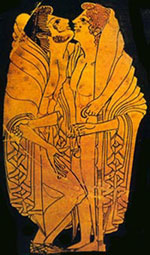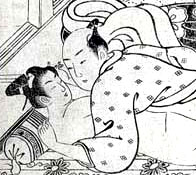 |
Sub-Saharan Africa
Much of the history of homosexual love in pre-colonial Africa has probably been lost for good. Pre-colonial Africa was largely made up of non-literate cultures that left no written records and the colonial powers were not inclined to document practices they considered "beastly"; they were already busy suppressing homosexuality at home. However, knowledge of some examples did survive, such as the boy marriage tradition among Azande warriors, and the gay sex customs at the court of the Kabaka (king) of the Buganda. It would be a stretch to call it "gay love" since those who did not submit to penetration - as a result of having recently been indoctrinated into Christian beliefs - were decapitated.
Arab Lands
From Andalusia under the Moors to North Africa and the Middle East, Arab cultures have made space for male love, even  though that space has often been hidden by a curtain of silence. Women are closely guarded in Arab society and thus unavailable for illicit relationships. Youths and men therefore have traditionally turned to each other for love and sexual relief. This love manifested in many ways. At one extreme it was a chaste religious practice where Sufi holy men gazed upon the beauty of a boy to come closer to God. At the other extreme, libertine poets like Abu Nuwas celebrated their gay conquests over unwilling or drunk boys. though that space has often been hidden by a curtain of silence. Women are closely guarded in Arab society and thus unavailable for illicit relationships. Youths and men therefore have traditionally turned to each other for love and sexual relief. This love manifested in many ways. At one extreme it was a chaste religious practice where Sufi holy men gazed upon the beauty of a boy to come closer to God. At the other extreme, libertine poets like Abu Nuwas celebrated their gay conquests over unwilling or drunk boys.
Classical Greece
The most civilized culture in antiquity also developed a highly evolved form of homosexual love. In ancient Greece love between males, or more precisely, love between young men and adolescent boys, was harnessed for the good of the state and of the lovers. Though not strictly gay love as we know it today, it was founded on the erotic passion between two males. It was held that the youth was enriched by the friendship of his lover and that the man strove to attain heights of achievement, in battle, sports or his profession, to be worthy of his beloved. These partnerships of lovers were said to make men undefeatable in battle. Seen in that light, one wonders what all the fuss is today in the US about gay soldiers.
Renaissance Italy
The list of Italian men of the fourteen, fifteen, and sixteen hundreds who are known to have had gay relationships reads like a who's who of artists and scientists: Marsilio Ficino did it with Giovanni Cavalcanti; Leonardo da Vinci did it with Salai (some say that is why his portrait was refused the honor of the modern Euro note); Benedetto Varchi did it with Giovanni de' Pazzi; Michelangelo did it with Cecchino de' Bracci and wrote a sonnet to celebrate it; Pope Julius III did it with Cardinal Innocenzo Ciocchi Del Monte; Benvenuto Cellini did it with Fernando di Giovanni di Montepulciano, kicked the boy out and was denounced by his spurned lover; Prospero Farinacci did it with Berardino Rocchi . . . but what is it that they all did? That was the business of the special police force, the "Gentlemen of the Night," that monitored men's wayward genitals in Florence of the time. Suffice it to say that they fell in love with each other, intoxicated by beauty and inspired by the recently re-discovered teachings of the ancients.
Northern Europe
 Though it is true that many Northern Europeans who were gay at heart traveled to Italy or North Africa to satisfy their homosexual desires, others plied their gay love at home. We do not know very much about the great majority who got away with it. They are a great invisible mass, like the submerged part of an iceberg. Usually, the ones we know about were the few who came to mischief. Among them is the great Russian composer Tchaikovsky, who had a fiery gay love affair with his teenage nephew and then was forced to commit suicide when he tried to seduce a nobleman's son. Another composer, Beethoven, was also deeply in love with his nephew, who finally tried to shoot himself in the head to escape his uncle's obsessive love. The loss of the boy plunged Beethoven into a deep depression which he did not survive. Their conversation books were destroyed by Beethoven's biographer as they were too incriminating. Jules Verne also had a misadventure with a nephew and a gun, only this time he was the target of the distraught boy. The nature of their relationship is not clear, but his love for the school boy Aristide Briand, later prime-minister of France, is well known. And let's not forget the paramount playwright of all time, William Shakespeare, who had the nerve and the genius to write one hundred and twenty six sonnets to his beloved youth, and only twenty five to his beloved lady. Though it is true that many Northern Europeans who were gay at heart traveled to Italy or North Africa to satisfy their homosexual desires, others plied their gay love at home. We do not know very much about the great majority who got away with it. They are a great invisible mass, like the submerged part of an iceberg. Usually, the ones we know about were the few who came to mischief. Among them is the great Russian composer Tchaikovsky, who had a fiery gay love affair with his teenage nephew and then was forced to commit suicide when he tried to seduce a nobleman's son. Another composer, Beethoven, was also deeply in love with his nephew, who finally tried to shoot himself in the head to escape his uncle's obsessive love. The loss of the boy plunged Beethoven into a deep depression which he did not survive. Their conversation books were destroyed by Beethoven's biographer as they were too incriminating. Jules Verne also had a misadventure with a nephew and a gun, only this time he was the target of the distraught boy. The nature of their relationship is not clear, but his love for the school boy Aristide Briand, later prime-minister of France, is well known. And let's not forget the paramount playwright of all time, William Shakespeare, who had the nerve and the genius to write one hundred and twenty six sonnets to his beloved youth, and only twenty five to his beloved lady.
India
Northern India under Mughal rule was a haven for gay love. Its icon has to be Mahmud of Ghazni, who deeply loved his boy slave, Ayaz. Their love has become a paragon of ideal love, perhaps analogous to that of Romeo and Juliet in the West. In a telling anecdote, Mahmud asks Ayaz, "who is the most powerful ruler in the world?" "I am the most powerful," Ayaz, the beloved slave replies. The confused king asks his slave boy to explain. "You, Mahmud, are the most powerful of all kings," says Ayaz. "But since I rule your heart, I am more powerful still." In popular lore the two were said to be each other's slave, Ayaz a slave in deed and Mahmud a slave of love.
 China
China
Love between men in China begins with the very beginning of history, with the first (semi-legendary) ruler, the Yellow Emperor. Historians claimed he was the first to establish the custom of taking a male bedmate. Many, if not most Chinese emperors had gay lovers. The tradition was known as the Way of the Cut Sleeve, or the Way of the Bitten Peach. China also stands out as one of the richest sources of erotic homosexual art. Sadly, only a small fraction has been preserved, as most of it was destroyed in the "Cultural" Revolution.
Japan
In an uncanny parallel with ancient Greece, Japan also possessed a rich and profound culture of love between men. All the shoguns had male lovers and the custom was one of the pillars of the samurai pedagogical tradition. Japanese erotic art, in the form of gay shunga, is refined and sophisticated. While much erotic shunga was destroyed during the era of Westernization--entire warehouses of erotic shunga prints were burned by the American occupying forces after WWII--a great deal survived and can be found in museums and treasured private collections of erotic art. It shows the endless ways men can love and make love with each other, and is marked with passion and humor.
Oceania
This land of countless tribes could boast an equal number of love customs until the recent occupation by Western powers and the forcible destruction of native customs. Among the lost traditions (replaced, presumably, with television and imported whiskey) is the tradition that included universal homosexuality. The Melanesian pattern involved young boys taking in the semen of a young man, often a relative, in order to attain masculinity. Upon reaching manhood, the former beloved would take a lover of his own, while the boy's mentor would leave the pleasure of gay sex behind and find himself a wife. The custom died out as soon as it was exposed to Western scrutiny and Christian dogma.
 Pre-Colombian America
Pre-Colombian America
The Mayan people, among their many cultural achievements, also developed a tradition of male love. One aspect involved nobles acquiring a slave or servant to be the playmate and bedmate of their son. Another aspect may have involved relations between an older chief and younger officials.
Native America
In The Two-Spirit tradition a child is recognized as different at a young age and brought up in the ways of the opposite sex. The custom is still honored among many Native American tribes today. Two-spirit people are thought to be endowed with special powers and are often respected as exceptional medicine people. In recent times, some two-spirits have transitioned between the gay world and the traditionalist world.
|
|
|
